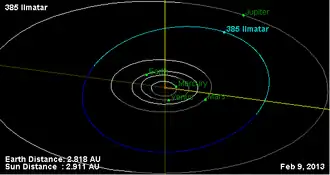385 Ilmatar
 Orbital diagram | |
| Discovery | |
|---|---|
| Discovered by | Max Wolf |
| Discovery date | 1 March 1894 |
| Designations | |
| (385) Ilmatar | |
Named after | Ilmatar |
| 1894 AX | |
| Main belt | |
| Orbital characteristics[1] | |
| Epoch 31 July 2016 (JD 2457600.5) | |
| Uncertainty parameter 0 | |
| Observation arc | 122.12 yr (44604 d) |
| Aphelion | 3.19998 AU (478.710 Gm) |
| Perihelion | 2.50226 AU (374.333 Gm) |
| 2.85112 AU (426.521 Gm) | |
| Eccentricity | 0.12236 |
| 4.81 yr (1758.4 d) | |
| 166.647° | |
| 0° 12m 17.024s / day | |
| Inclination | 13.5514° |
| 345.021° | |
| 187.911° | |
| Physical characteristics | |
| 83.857±0.576 km[1] | |
| Mass | (1.039 ± 0.515/0.201)×1018 kg[2] |
Mean density | 3.136 ± 1.555/0.607 g/cm3[2] |
| 62.35 h (2.598 d) | |
| 0.242±0.042[1] | |
| S | |
| 7.85[1] | |
385 Ilmatar is a large main belt asteroid.
It was discovered by Max Wolf on March 1, 1894, in Heidelberg.[3] It was named after Ilmatar, virgin spirit of the air from the Finnish epic Kalevala. Its mass has been estimated as (1.039 ± 0.515/0.201)×1018 kg.[2] Its rotation is 62.35 hr.
References
- ^ a b c d "385 Ilmatar (1894 AX)". JPL Small-Body Database. NASA/Jet Propulsion Laboratory. Retrieved 10 May 2016.
- ^ a b c Fienga, A.; Avdellidou, C.; Hanuš, J. (February 2020). "Asteroid masses obtained with INPOP planetary ephemerides". Monthly Notices of the Royal Astronomical Society. 492 (1): 589–602. doi:10.1093/mnras/stz3407.
- ^ "Physics and Astronomy > Dictionary of Minor Planet Names > (385) Ilmatar". Springer Reference. Retrieved 20 October 2014.
External links
- 385 Ilmatar at AstDyS-2, Asteroids—Dynamic Site
- 385 Ilmatar at the JPL Small-Body Database